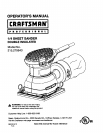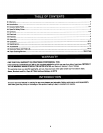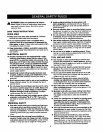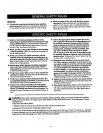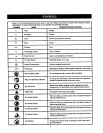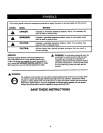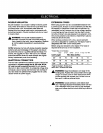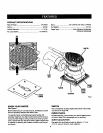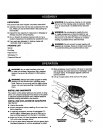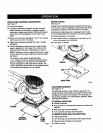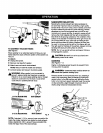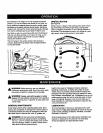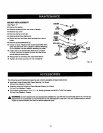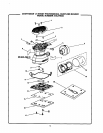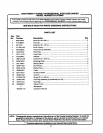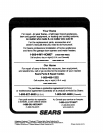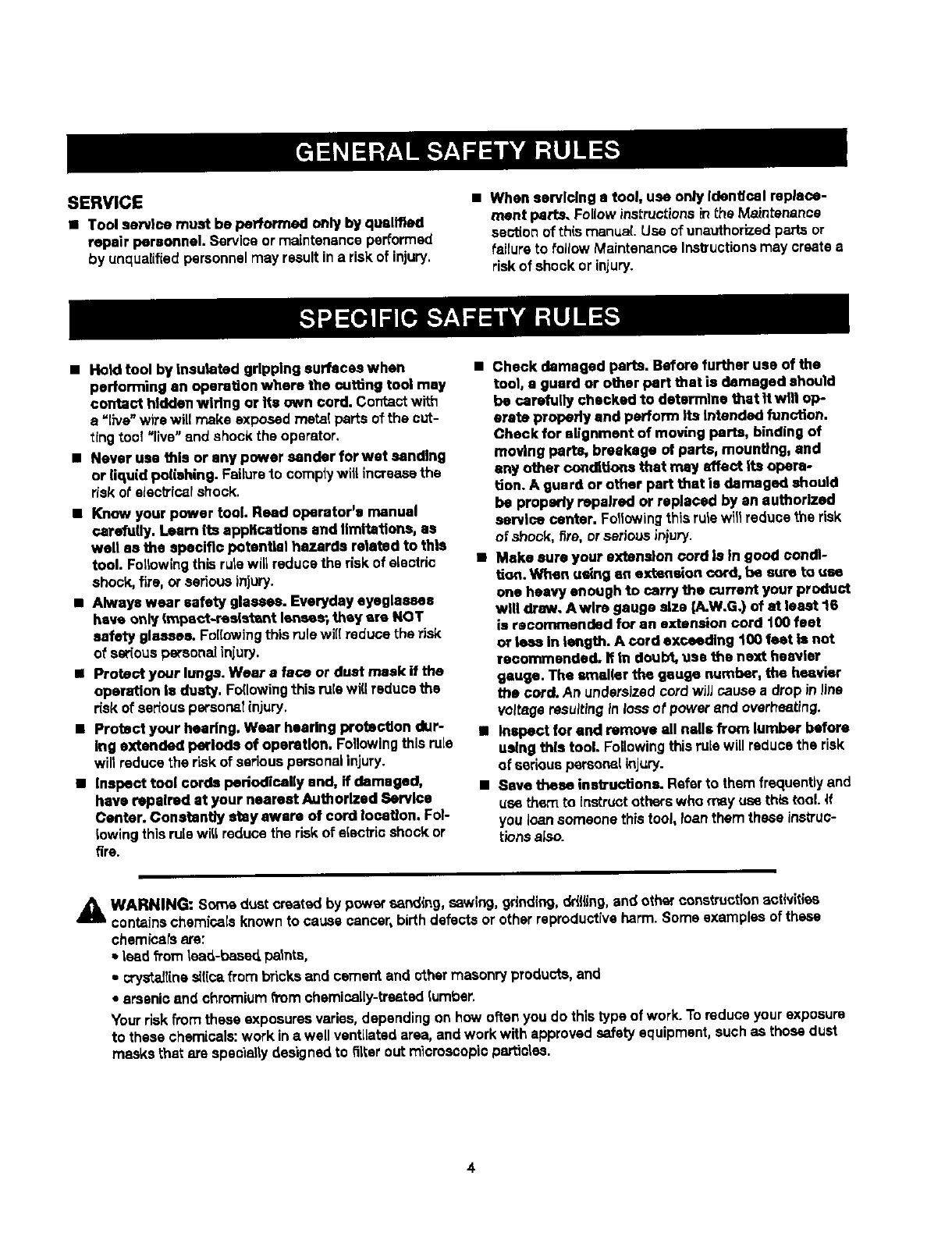
SERVICE
• Tool service must be performed only by qualified
repair personnel. Serviceor maintenanceperformed
by unqualifiedpersonnelmay re,suitin a riskof injury.
• When servicing • tool, use only Identical replace-
ment parts, Followins;:ructionsin the Maintenance
section of thLsmanual. Use ofunauthorizedparts or
failure to follow Maintenance Instructionsmay createa
riskofshock or injury.
• Hold tool by Insulated gripping surhlcse when
performing an operation where the cutting tool may
contact hidden wiring or Its own cord. Contactwith
e "live"wire will make exposedmetal parts of the cut-
tingtool "live"and shockthe operator.
I Never use this or any power sander for wet sanding
or (io,uid polishing. Failureto comptywill increasethe
risk o#electricalshock.
• Know your power tool. Read operator's manual
carefully. Learn Its applications end limitations, as
well as the specific potential hazards related to this
tool. Followingthisrutswill reduceths riskof electric
shock,firs, or seriousInjury.
• Always wear safety glasses. Everyday eyeglasses
have only_mpsct-re=dstsnt lenses; they ere NOT
safety glasses. Followingthis rulewil(reduce the risk
ofsedous personalinlury.
• Proteof your lungs. Wear e face or dust meek if the
operation Is dusty. Fallowingthisrulewi[Ireducethe
riskofserious perser_l injury.
• Protect your hearing, Wear hearing protection dur-
Ing extended Periods of operation. Followingthis rule
wiltreduce therisk of seriouspersonal injury.
• Inspect tool cords lc_icxliceHy end, ffdamaged,
have repaired at your nearest Authorized ServJca
Center. Constantly stay aware of cord location. Fol-
lowing thisrulewJilreduce therisk of eisctrJcshock or
fire.
• Check damaged parts. Before further use of the
tool, • guard or other pert that is damaged should
be carefully checked to determine that It will op-
erate properly and perform its intended function.
Check for alignment of moving parts, binding of
moving parts, breakage of parts, recur=ling,and
any other conditions that may effect It_ opera.
Uon. A guard or other part that is damaged should
be propEwlyrepaired or replaced by an authorized
service center. Followingthis rulewfffreduce the risk
of shock, fire, or seriousinjury.
• Make sure your extension cord is In good oondl-
tia_'LWhen using an extsns_oncord, be sure to use
one heavy enough to carry the current your product
will draw. Awlre gauge size {A,W.G.) of at least 16
is recommended for an extension cord I00 feet
or tess In leagth. A cord exceeding 100 feat is not
reoon'mnondod. If in doubt, use the next heavier
gaul. The =-nailer the gauge number, the he=vler
the cord. An undersized cord wJJJcauses dropin line
vol_tgsresultingInlossof power end overheating.
• Inspect for end remove all nails from lumber before
using this tool. Followingthis rulewill reducethe risk
ofseriouspersePalInjury.
• Save these Instructions. Referto them frequentlyand
use _ to instruct othe_swhomay usethistool. If
you loan someone this tool, loan them these instruc-
tionsa/so.
WARNING: Somadust crsatad by power sanding,sawing,grinding, drilling,end otherconstructionactivities
containschemicalsknown to cause cancer,birthdefectsor other reproductiveharm.Some examples ofthese
chemicalsare:
• lead from lead-based, palms,
. crystallines_t(cafrom bricksand cement and othermasonry produc_s,and
• arsenicand chromiumit'om chemically-treated{umber.
Yourriskfromthese exposuresvaries, dependingon how oftenyou do thistype of work.To reduce yoursxposum
to thesechemicals:work ina well ventilatedarea, andwork with approved Safetyequipment,such as thosedust
maskstha_are speciallydesignedto filterout microscopic particles.
4



